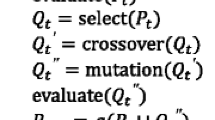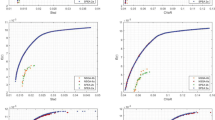Abstract
The complexity of the financial systems inevitably leads to the uncertain information and random information simultaneously. Because asset returns frequently show excessive kurtosis and tend to be skewed, we consider an uncertain random higher moments portfolio optimization problem in this paper, in which uncertain and random return rates exist simultaneously. First, the concept of kurtosis for uncertain random variable is defined and the deterministic expressions of kurtosis under three kinds of distributions are derived. Then, an uncertain random mean-variance-skewness-kurtosis-entropy model is formulated with two auxiliary models for portfolio optimization problem. After solving the equivalent deterministic model with NSGA-II algorithm, we propose a new optimal solution criterion for finding a single optimal solution in Pareto optimal solution set. Finally, we present a numerical simulation and obtain the following results: (i) the practicability and the validity of the proposed model, the NSGA-II algorithm and the optimal selection criterion have verified; (ii) the size of population has an obvious influence on the single optimal solution; (iii) the parameter adjustment has a significant impact on the results, and the results are in perfect agreement with the actual situation.














Similar content being viewed by others
Explore related subjects
Discover the latest articles, news and stories from top researchers in related subjects.Data availibility
The authors confirm that the data supporting the findings of this study are available within the article and its supplementary materials.
References
Ahmadzade H, Gao R, Dehghan MH (2018) Partial triangular entropy of uncertain random variables and its application. J Amb Intel Hum Comp 9(5):1455–1464
Arditti FD (1971) Another look at mutual fund performance. J Financ Quant Anal 6(3):909–912
Chang J-H, Sun L, Zhang B, Peng J (2020) Multi-period portfolio selection with mental accounts and realistic constraints based on uncertainty theory. J Comput Appl Math 377:112892
Chen S-X (2008) Nonparametric estimation of expected shortfall. J Financ Economet 6(1):87–107
Chen W, Yun W, Zhang J, Lu S (2017) Uncertain portfolio selection with high-order moments. J Intell Fuzzy Syst 33(3):1397–1411
Chen W, Wang Y, Gupta P, Mehlawat MK (2018) A novel hybrid heuristic algorithm for a new uncertain mean-variance-skewness portfolio selection model with real constraints. Appl Intell 48(9):2996–3018
Chen W, Li D, Liu Y-J (2019) A novel hybrid ICA-FA algorithm for multi-period uncertain portfolio optimization model based on multiple criteria. IEEE T Fuzzy Syst 27(5):1023–1036
Clarke RG, Harindra DS, Steven T (2006) Minimum-variance portfolios in the US equity market. J Portfolio Manage 33(1):10–24
Deb K, Agrawal S, Pratab A, Meyunivan T (2002) A fast elitist non-dominated sorting algorithm for multi-objective optimization NSGA-II. IEEE T Evolut Comput 6:182–197
Demiguel V, Garlappi L, Nogales FJ, Uppal R (2009) A generalized approach to portfolio optimization: improving performance by constraining portfolio norms. Manag Sci 55(5):798–812
Deng X, Li R (2012) A portfolio selection model with borrowing constraint based on possibility theory. Appl Soft Comput 12(2):754–758
Deng X, Liu Y-L (2018) A high-moment trapezoidal fuzzy random portfolio model with background risk. J Sys Sci Info 6(1):1–28
Dhanalakshmi S, Kannan S, Mahadevan K, Baskar S (2011) Application of modified NSGA-II algorithm to combined economic and emission dispatch problem. Int J Elec Power 33(4):992–1002
El-Abbasy MS, Elazouni A, Zayed T (2020) Finance-based scheduling multi-objective optimization: benchmarking of evolutionary algorithms. Automat Constr 120:103392
Hao F-F, Liu Y-K (2009) Mean-variance models for portfolio selection with fuzzy random returns. J Appl Math Comput 30(1):9–38
Harvey CR, Liechty J, Liechty M, Muller P (2010) Portfolio selection with higher moments. Quant Financ 10(5):469–485
Huang X-X (2007) A new perspective for optimal portfolio selection with random fuzzy returns. Inf Sci 177(23):5404–5414
Huang X-X, Jiang G-W (2021) Portfolio management with background risk under uncertain mean-variance utility. Fuzzy Optim Decis Mater 20(3):315–330
Huang X-X, Wang X-T (2021) International portfolio optimization based on uncertainty theory. Optimization 70(2):225–249
Kannan S, Baskar S, Mccalley JD (2009) Application of NSGA-II algorithm to generation expansion planning. IEEE Trans Power Syst 24(1):454–461
Konno H, Suzuki KI (1995) A mean-variance-skewness portfolio optimization model. J Oper Res Soc Jpn 38(2):173–187
Konno H, Shirakawa H, Yamazaki H (1993) A mean-absolute deviation-skewness portfolio optimization model. Ann Oper Res 45(1):205–220
Kwakernaak H (1978) Fuzzy random variables-I. definitions and theorems. Inf Sci 15(1):1-29
Li B, Shu Y-D (2022) The skewness for uncertain random variable and application to portfolio selection problem. J Manag Optim 18(1):457–467
Li J, Xu J-P (2009) A novel portfolio selection model in a hybrid uncertain environment. Omega Int J Manag Sci 37(2):439–449
Li B, Zhang R-R (2021) A new mean-variance-entropy model for uncertain portfolio optimization with liquidity and diversification. Chaos Soliton Fract 146:110842
Li B, Zhu Y-G, Sun Y-F, Aw G, Teo KL (2018) Multi-period portfolio selection problem under uncertain environment with bankruptcy constraint. Appl Math Model 56:539–550
Liu B-D (2007) Uncertainty theory, 2nd edn. Springer, Berlin, pp 1–79
Liu B-D (2009) Some research problems in uncertainty theory. J Uncertainity Syst 3(1):3–10
Liu B-D (2010) Uncertainty theory: a branch of mathematics for modeling human uncertainty. Springer, Berlin
Liu Y-H (2013) Uncertain random variables: a mixture of uncertainty and randomness. Soft Comput 17(4):625–634
Liu S, Wang S-Y, Qiu W (2003) Mean-variance-skewness model for portfolio selection with transaction costs. Int J Syst Sci 34(4):255–262
Liu X-M, Latif Z, Wang C-F, Latif S, Wang X (2018) Mean-variance-kurtosis hybrid multi-objective portfolio optimization model with a defined investment ratio. J Eng Technol 6(1):293–306
Mardia KV (1970) Measures of multivariate skewness and kurtosis with applications. Biometrika 57(3):519–530
Maringer D, Parpas P (2009) Global optimization of higher order moments in portfolio selection. J Global Optim 43(2):219–230
Markowitz HM (1952) Portfolio selection. J Financ 7(1):977–91
Martel JM, Khoury NT, Bergeron M (1988) An application of a multicriteria approach to portfolio comparisons. J Oper Res Soc 39(7):617–628
Mehlawat MK, Gupta P, Khan AZ (2021) Portfolio optimization using higher moments in an uncertain random environment. Inf Sci 567:348–374
Mittal SK, Srivastava N (2021) Mean-variance-skewness portfolio optimization under uncertain environment using improved genetic algorithm. Artif Intell Rev 54(8):6011–6032
Pahade JK, Jha M (2021) Credibilistic variance and skewness of trapezoidal fuzzy variable and mean-variance-skewness model for portfolio selection. Results Math 11:100159
Qin Z-F (2015) Mean-variance model for portfolio optimization problem in the simultaneous presence of random and uncertain returns. Eur J Oper Res 245(2):480–488
Qin Z-F, Kar S, Zheng H (2016) Uncertain portfolio adjusting model using semiabsolute deviation. Soft Comput 20(3):717–725
Qin Z, Dai Y, Zheng H (2017) Uncertain random portfolio optimization models based on value-at-risk. J Intell Fuzzy Syst 32(6):4523–4531
Rui Q, Hao F-F (2008) Computing the mean chance distributions of fuzzy random variables. J Uncertain Syst 2(4):299–312
Samuelson P (1970) The fundamental approximation theorem of portfolio analysis in terms of means, variances and higher moments. Rev Econ Stud 37(4):537–542
Sanford A (2022) Optimized portfolio using a forward-looking expected tail loss. Financ Res Lett 46:102421
Sheng Y-H, Yao K (2014) Some formulas of variance of uncertain random variable. J Uncertain Anal Appl 2(1):1–10
Srinivas N, Deb K (1994) Multiobjective optimization using nondominated sorting in genetic algorithms. Evol Comput 2(3):221–248
Sun Y-F, Aw G, Teo KL, Zhou G-L (2015) Portfolio optimization using a new probabilistic risk measure. J Ind Manag Optim 11(4):1275–1283
Tasche D (2002) Expected shortfall and beyond. J Bank Financ 26(7):1519–1533
Wilcox J (2020) Better portfolios with higher moments. J Asset Manag 21(7):569–580
Zadeh LA (1965) Fuzzy sets. Inform Control 8(3):338–353
Zhai J, Bai M (2018) Mean-risk model for uncertain portfolio selection with background risk. J Comput Appl Math 330:59–69
Zhang P (2016) Multiperiod mean absolute deviation uncertain portfolio selection. Soft Comput 15(1):1–18
Zhang Q-F, Hui L (2008) MOEA/D: a multiobjective evolutionary algorithm based on decomposition. IEEE Trans Evolut Comput 11(6):712–731
Acknowledgements
This work is supported by the Natural Science Foundation of Jiangsu Province (Nos. BK20190787 and BK20210605).
Author information
Authors and Affiliations
Corresponding author
Ethics declarations
Conflict of interest
The authors declare that they have no known competing financial interests or personal relationships that could have appeared to influence the work reported in this paper.
Additional information
Publisher's Note
Springer Nature remains neutral with regard to jurisdictional claims in published maps and institutional affiliations.
Appendix
Appendix
The proof of Theorem 2
Proof
Based on Definition 5 in Liu (2013a) and Definition 3, we have
where Ch is the chance measure of uncertain random event. Because \(\left( \eta -E[\eta ]\right) ^{4}\) is non-negative, it holds that
Here, it follows from Stipulation 2.3 in Liu (2007) that
Letting \(x=E[\eta ]+\root 4 \of {r}\) (\(r=\left( x-E[\eta ]\right) ^{4}\)) and taking integration by parts, we have
The proof is completed. \(\square\)
The proof of Theorem 3
Proof
According to Definition 3, we have
The proof is completed. \(\square\)
The proof of Theorem 7
Proof
We construct a Lagrange function to calculate the maximum value of investment diversification in (5.8)
Taking the partial derivatives of \(L(u_{1},u_{2},\cdots ,u_{m},u_{m+1},u_{m+2},\cdots ,u_{m+n},\lambda )\) with respect to \(u_{1},u_{2},\) \(\cdots ,u_{m+n}\) and \(\lambda\), we can get
Then, set all the partial derivatives equal to zero, it follows that
We can get the result that \(u_{1}=u_{2}=\cdots =u_{m+n}=\displaystyle \frac{1}{m+n}\), and the maximum value of the corresponding investment diversification is \(-\ln \left( \displaystyle \frac{1}{m+n}+\varepsilon \right)\). Conversely, when investors invest all their assets in a single asset, the value of investment diversification will reach a minimum of zero. The proof is completed. \(\square\)
Rights and permissions
Springer Nature or its licensor (e.g. a society or other partner) holds exclusive rights to this article under a publishing agreement with the author(s) or other rightsholder(s); author self-archiving of the accepted manuscript version of this article is solely governed by the terms of such publishing agreement and applicable law.
About this article
Cite this article
Li, X., Li, B., Jin, T. et al. Uncertain random portfolio optimization with non-dominated sorting genetic algorithm-II and optimal solution criterion. Artif Intell Rev 56, 8511–8546 (2023). https://doi.org/10.1007/s10462-022-10388-x
Published:
Issue Date:
DOI: https://doi.org/10.1007/s10462-022-10388-x




